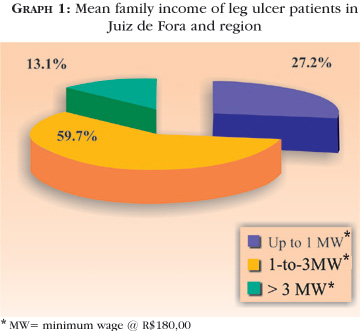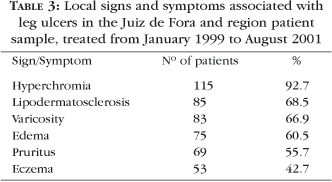BACKGROUND: Leg ulcers are characterized as tissue loss in the lower extremities, generally caused by vascular dysfunction. OBJECTIVES: Verify the clinical and epidemiological profiles of the population sample with leg ulcers treated at the health centers of Juiz de Fora (Brazil). MATERIAL AND METHODS: 124 leg-wound patients were evaluated between January 1999 and August 2001 and submitted to a clinical protocol. RESULTS: The mean age was 64 years, with females in the majority (65.3%). The mean family composition was 3.7 persons, and family income was around US$200.00 (86.8%). Venous insufficiency (90.3%), systemic arterial hypertension (54%), obesity (20.2%) and diabetes mellitus (16.1%) were the most frequent events associated with the ulcers. An association of venous insufficiency and arterial hypertension was frequent in 43.7% of the sample, and significant (p<0.01) to predisposition to the ulcers. These were classified as venous (79%), hypertensive (15.4%), mixed and other (5.6%). The ulcers were generally localized in the distal third of legs (90%) and considered large (5 cm) in about 90% of the sample, with means of 8.7 cm and 9.6 cm to vertical and horizontal axes, respectively. The ulcers were accompanied mainly by hyperpigmentation (92.7%), lipodermatosclerosis (68.5%) and varicose veins (66.9%), with a mean duration of 94.2 months and 50% of them recurrent. CONCLUSIONS: The data suggested that leg ulcer is an important chronic disease in the elderly and poor population of Juiz de Fora and region.
Aged; Income; Family income; Leg ulcers; Varicose veins






